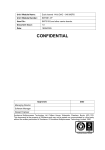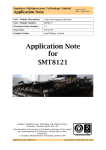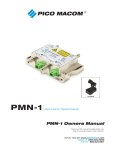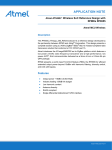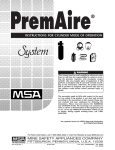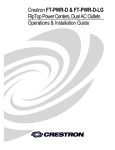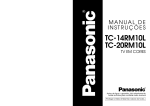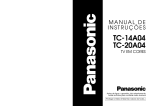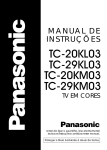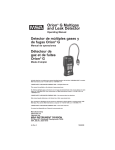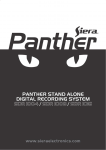Download SMT381 User Manual - Sundance Multiprocessor Technology Ltd.
Transcript
Sundance Multiprocessor Technology Limited User Manual Unit / Module Description: 1Gsps dual channel 14bits DAC Unit / Module Number: SMT381 Document Issue Number: 1.0 Issue Date: 06/2007 Original Author: Jean-Philippe Arnaud Form : QCF42 Date : 6 July 2006 User Manual for SMT381 Sundance Multiprocessor Technology Ltd, Chiltern House, Waterside, Chesham, Bucks. HP5 1PS. This document is the property of Sundance and may not be copied nor communicated to a third party without prior written permission. © Sundance Multiprocessor Technology Limited 2006 User Manual SMT381 Last Edited: 12/06/2007 10:43:00 Revision History Issue 1.0 Changes Made New document User Manual SMT381 Page 2 of 31 Date Initial s 06/2007 JPA Last Edited: 12/06/2007 10:43:00 Table of Contents 1 Introduction ................................................................................................................6 1.1 Module Features .......................................................................................................6 1.2 Possible applications.................................................................................................6 2 Related Documents....................................................................................................7 2.1 Referenced Documents .............................................................................................7 2.2 Applicable Documents ..............................................................................................7 3 Acronyms, Abbreviations and Definitions ...........................................................8 3.1 Acronyms and Abbreviations ...................................................................................8 3.2 Definitions .................................................................................................................8 4 Functional Description.............................................................................................9 4.1 Block Diagram...........................................................................................................9 4.2 Main analogue features ..........................................................................................10 4.3 Clock structure........................................................................................................10 4.4 Analogue output......................................................................................................12 4.5 SLB ..........................................................................................................................14 5 Performance..............................................................................................................14 5.1 6 Waveform Memory..................................................................................................14 Footprint ....................................................................................................................18 6.1 Components location...............................................................................................18 6.2 Test points ...............................................................................................................19 7 Support Packages ....................................................................................................21 7.1 SMT368A.................................................................................................................21 7.1.1 SMT381Control task ..........................................................................................22 7.1.2 Registers_381 task .............................................................................................22 7.1.3 Clock_dac_381v4 task ........................................................................................24 7.1.4 Clock_dac_381v4_div4 task ...............................................................................25 7.1.5 DAC381 task.......................................................................................................25 7.1.6 Sine task .............................................................................................................25 7.1.7 Duplicate task.....................................................................................................25 8 Physical Properties .................................................................................................26 8.1 Mechanical Interface ..............................................................................................26 8.2 Electrical Interface .................................................................................................26 9 Safety ..........................................................................................................................27 10 EMC .............................................................................................................................28 11 Appendix ....................................................................................................................28 User Manual SMT381 Page 3 of 31 Last Edited: 12/06/2007 10:43:00 11.1 Description of the registers ....................................................................................28 11.1.1 The Reset Register (Write Add 0x000)..............................................................28 11.1.2 Temperature Registers (Read Add 0x020, 0x021, 0x028, 0x029) ....................28 11.1.3 DAC Clock Source Registers (Write Add 0x801) ..............................................29 11.1.4 Clock Synthesizer Setup Register (Write Add 0x800)......................................29 11.1.5 PLL Setup Registers (Write Add 0x802 – 0x809) .............................................30 11.1.6 Data Source Selection (Write Add 0x80E) ........................................................30 11.1.7 DAC Setup Registers (Write Add 0x900 – 0x905) ............................................31 User Manual SMT381 Page 4 of 31 Last Edited: 12/06/2007 10:43:00 Table of Figures Figure 1: block diagram of the SMT381 ................................................................................9 Figure 2: Clock tree of the SMT381 .....................................................................................11 Figure 3. Option 1 for the SMT381 analog output stage. ...................................................12 Figure 4. Option 2 for the SMT381 analog output stage. ...................................................13 Figure 5: Combined analogue output circuit.......................................................................13 Figure 6: Waveform Memory - Time View Capture – 1000Msps (VCO) – 125MHz analogue output ............................................................................................................14 Figure 7: Measurements of Capture – 1000Msps (VCO) – 125MHz analogue output......15 Figure 8: Waveform Memory - FFT – 1000Msps (VCO) – 125MHz analogue output – Channel A......................................................................................................................15 Figure 9: Waveform Memory - FFT – 1000Msps (VCO) – 125MHz analogue output – Channel B......................................................................................................................16 Figure 10: Waveform Memory - FFT – 600Msps (VCO) – 75MHz analogue output – ChannelA.......................................................................................................................16 Figure 11: Waveform Memory - FFT – 600Msps (VCO) – 75MHz analogue output – ChannelB.......................................................................................................................17 Figure 12: Connector Location on SMT381.........................................................................18 Figure 13: Test point locations on the SMT381 ..................................................................20 Figure 14: example block diagram.......................................................................................21 Figure 15 Setup Packet Structure .......................................................................................22 Figure 16: Packet Structure – Defined Commands: ...........................................................22 Figure 17: Reset Register (Write Only) ...............................................................................28 Figure 18: Temperature Registers (Read Only) ..................................................................29 Figure 19: Clock Source Selection Table (Write Only) .......................................................29 Figure 20: PLL Setup Registers (Write Only) .....................................................................30 Figure 21: Data Source Selection.........................................................................................31 Figure 22: DAC Setup Registers (Write Only) ....................................................................31 User Manual SMT381 Page 5 of 31 Last Edited: 12/06/2007 10:43:00 1 Introduction The SMT381 is a single width expansion daughter module capable of converting two external digital inputs at 1Gsps with a resolution of 14 bits. A Fujitsu dual channel DAC (MB86064) performs the digital to analogue conversion. The SMT381 plugs onto a base board which provides an FPGA to interface to the DAC and control the SMT381. Base board currently available with the SMT381 are • SMT338-VP 1 , • SMT368A. 1.1 Module Features The main features of the SMT381 are listed underneath: • Dual channel DAC • 1 GSPS conversion frequency • 14 bit data resolution • Custom Clock and Trigger inputs via external connectors • Internal Waveform generator • Standard Sundance comport and SHB interfaces for easy interconnection to Sundance products via base module. 1.2 Possible applications The SMT381 can be used for the following applications (this non-exhaustive list should be taken as an example): • Broadband cable modem head-end systems • 3G Radio transceivers • High-data-rate point-to-point radios • Medical imaging systems • Spectrum analyzers 1 Note that when the SMT381 is coupled with the SMT338-VP, sampling rate of 1Gsps is only achievable when using the internal memory of the DAC. Limitations in the Virtex2pro architecture limit the frequency to 840Msps with the parallel interface of the DAC. User Manual SMT381 Page 6 of 31 Last Edited: 12/06/2007 10:43:00 2 Related Documents Sundance LVDS Bus (SLB) specifications Fujitsu MB86064 DAC datasheet SMT368 SMT338-VP 2.1 Referenced Documents 2.2 Applicable Documents User Manual SMT381 Last Edited: 12/06/2007 10:43:00 3 Acronyms, Abbreviations and Definitions 3.1 Acronyms and Abbreviations 3.2 Definitions User Manual SMT381 Last Edited: 12/06/2007 10:43:00 4 Functional Description 4.1 Block Diagram The following diagram represents the architecture of the SMT381 daughter module. Figure 1: block diagram of the SMT381 The SMT381 is a daughter board that plugs onto a base board. The base board sends the digital samples for the DAC and control data for the on-board clocks and the DAC via the SLB connector. There are two DAC cores present in the MB86064. Thus two channels are available for outputs. The outputs of the DAC are differential currents, which are converted to a voltage by the analogue output stage (RF Transformer). There are three sources for the sampling clock of the DAC • the on-board VCO, • the on-board Clock synthesizer, • the external clock can be provided as an LVPECL clock or as an RF clock (two separate inputs). User Manual SMT381 Last Edited: 12/06/2007 10:43:00 The sampled data can either be supplied to the DAC cores externally via its LVDS data bus or internally from the Waveform Memory Module. The data may be routed to the DAC cores through a number of paths. The most direct path routes data straight from the LVDS input buffers to the DAC core input latches. All digital functions on the module are controlled by the FPGA of the base board. 4.2 Main analogue features The main analogue characteristics of the SMT381 are listed in the following table: Analogue outputs Output current range 20mA Data Format Analogue current External sampling clock inputs (The clock frequency is divided by 2 on the SMT381 for a DDR clock for the DAC) LVPECL Clock Signal format LVPECL Frequency range 25MHz to 1000 MHz RF Clock Signal format Sinus wave Frequency range 25MHz to 1000 MHz Amplitude 0dBm Typ External trigger inputs Signal format LVPECL Frequency range DC to 100 MHz DAC performance @ Single tone at -1dBFS, 800MSa/s, DC to 400MHz (From DAC datasheet) Spurious Free Dynamic Range (SFDR) @ 20MHz 75dBc Spurious Free Dynamic Range (SFDR) @ 300MHz 58dBc Cross-talk 4 tone test, each tone at -15dBFS, centred at 276MHz 67dBc Table 1: main analogue features 4.3 Clock structure There are two integrated clock generators on the module. The user can either use these clocks or provide the module with an external clock (input via MMBX connectors). The following figure shows the SMT381 clock tree. User Manual SMT381 Page 10 of 31 Last Edited: 12/06/2007 10:43:00 Figure 2: Clock tree of the SMT381 The main clock tree of the SMT381 consists of two clock sources to achieve the DAC’s full range of input frequencies (DC – 500MHz). The first clock source is a MICREL clock synthesizer which has a range from 50MHz to 950MHz. This source’s disadvantage however is that it has a jittery output and thus the clock is not that stable. Its advantage however is that it can attain a wide range of frequencies, especially the lower frequencies. The output clock is LVPECL. The second clock source is a Voltage Controlled Oscillator (VCO) with a phase lock loop. This combination has a very stable output. However a limited frequency range can be attained by this combination (300MHz – 600MHz). This is achieved by taking a 600MHz -1200MHz VCO and dividing the output by 2. The output clock must also be scaled to LVPECL. Alternatively the user can provide the module with an external LVPECL clock or an external RF clock. The user can select between any of these input clocks. User Manual SMT381 Page 11 of 31 Last Edited: 12/06/2007 10:43:00 The selected clock then drives the DAC and is also distributed to the base board for data synchronization purposes. On the FPGA of the base board a PLL synchronizes the clock with the data being sent by using the supplied clock and looping that same clock to the DAC and back. This technique synchronizes the clock to the data is being sent out on (base board side) even further with the clock used in the DAC. Synchronization issues become a bigger factor as the clock frequencies get bigger. All the clock control is done on the base board in firmware on the FPGA. 4.4 Analogue output Two options are hardwired into the design. The options are shown below with a figure of each. Option 1 Single ended AC coupled output with Macom TP-101 transformer. TP101 Output Connector + R1 R1 Figure 3. Option 1 for the SMT381 analog output stage. Option 2 Differential DC coupled output with + and – channels going to separate connectors User Manual SMT381 Page 12 of 31 Last Edited: 12/06/2007 10:43:00 Output Connector + R2 R2 Output Connector Figure 4. Option 2 for the SMT381 analog output stage. Combined circuit The two combined: 0 ohm TP101 + R3 R3 0 ohm Figure 5: Combined analogue output circuit Depending on whether an AC or DC coupled version is ordered the board will be assembled accordingly to either give the AC or DC coupled circuit shown above. For more information consult the Fujitsu (MB86064) DAC datasheet. User Manual SMT381 Page 13 of 31 Last Edited: 12/06/2007 10:43:00 4.5 SLB The SMT381 connects to a base module (SMT338-VP, SMT398-VP, SMT368) via the SLB connector. Refer to the SLB specification document for more information. 5 Performance 5.1 Waveform Memory In the following captures the waveform memory is set up for a cyclic run of 8 samples per channel and a sinus wave programmed into the memory. One complete cycle of the wave is loaded into the memory, resulting in a waveform being generated at 1/8th of the sample frequency. The DAC sample frequency is double that of the clock supplied to the DAC. So for eg if a 500MHz clock is given to the DAC with the waveform memory initialized as described above the DAC sample frequency will be 1000MHz and the generated wave will be 125MHz (1000MHz divided by 8). Figure 6: Waveform Memory - Time View Capture – 1000Msps (VCO) – 125MHz analogue output User Manual SMT381 Page 14 of 31 Last Edited: 12/06/2007 10:43:00 Figure 7: Measurements of Capture – 1000Msps (VCO) – 125MHz analogue output Figure 8: Waveform Memory - FFT – 1000Msps (VCO) – 125MHz analogue output – Channel A User Manual SMT381 Page 15 of 31 Last Edited: 12/06/2007 10:43:00 Figure 9: Waveform Memory - FFT – 1000Msps (VCO) – 125MHz analogue output – Channel B Figure 10: Waveform Memory - FFT – 600Msps (VCO) – 75MHz analogue output – ChannelA User Manual SMT381 Page 16 of 31 Last Edited: 12/06/2007 10:43:00 Figure 11: Waveform Memory - FFT – 600Msps (VCO) – 75MHz analogue output – ChannelB User Manual SMT381 Page 17 of 31 Last Edited: 12/06/2007 10:43:00 6 Footprint 6.1 Components location The following diagram indicates the location of all the important connectors and components on the SMT381 (Rev 1) PCB. Figure 12: Connector Location on SMT381 Diagram Ref Pcb RefDes Description Notes A J11 External Trigger B Channel LVPECL Signal. Positive on inside of connector. Negative on outside of connector. B J10 External Trigger A Channel LVPECL Signal. Positive on inside of connector. Negative on outside of connector. C J13 DAC Output B Channel (neg) Analog Signal. Signal on inside of connector. GND on outside of connector. For DC Coupling only (differential signal, split over both connectors). D J3 DAC Output B Channel (pos) Analog Signal. Signal on inside of connector. GND on outside of connector. For AC Coupling (single ended), and pos side of DC coupling (differential) E J12 DAC Output A Channel (neg) Analog Signal. Signal on inside of connector. GND on outside of connector. For DC Coupling only (differential signal, split over both connectors). F J2 DAC Output A Channel (pos) Analog Signal. Signal on inside of connector. GND on outside of connector. For AC Coupling (single ended), and pos side of DC coupling (differential). G J1 DAC Test Clock Output LVPECL output test clock. Copy of clock going to DAC. Postive on inside of connector, negative on outside of User Manual SMT381 Last Edited: 12/06/2007 10:43:00 connector. Used for verification of the clock going to the DAC. H J5 External RF clock input External Analog input Clock to DAC. Clock on inside of connector, DGND on the outside of connector. I J4 External ECL clock input External ECL input Clock to DAC. Positive on inside of connector, negative on the outside of connector. Table 2: Table of Connector Locations on SMT381 Diagram Ref Pcb RefDes Description Notes J J8 FPGA / Connector K U9 Fujitsu DAC L TRANS2 M/A Com Transformer TP101 By default the SMT381 analog input is AC coupled through a twisted pair balum transformer (differential to single ended). It is possible to change this configuration to DC coupled by taking out the transformer and inserting some resistors on the board. M TRANS1 M/A Com Transformer TP101 By default the SMT381 analog input is AC coupled through a twisted pair balum transformer (differential to single ended). It is possible to change this configuration to DC coupled by taking out the transformer and inserting some resistors on the board. N VCO1 UMC 600 – 1200MHz VCO O U31 Clock Synthesizer 950MHz MSP JTAG FPGA / MSP430 on SMT338-VP JTAG Chain. Only routed down to SMT338-VP. Use for easy access without having to remove the SMT381. DAC Requires heat-sink with air-flow cooling in a system setup. 50 System Clock for the DAC. VCO Requires heat-sink with air-flow cooling in a system setup. – Test Clock for DAC. The range of this clock is wider than the operating range of the DAC. Table 3: Table of Component Locations on SMT381 6.2 Test points The following diagram shows all the Test points present on the board. User Manual SMT381 Page 19 of 31 Last Edited: 12/06/2007 10:43:00 Figure 13: Test point locations on the SMT381 TP1 – External Clock positive TP2 – External Clock negative TP3 – Daughter Card Connector test point TP4 – Daughter Card Connector test point TP5 – Daughter Card Connector test point TP6 – Daughter Card Connector test point TP7 – 1V8 test point TP8 – 3V3_IN test point TP9 – ECL 5V test point TP10 – 3V3 test point TP11 – ECL -5V2 test point TP12 – Analog 3V3 TP13 – VCO 12V TP14 – VCO 5V TP15 – VCO Clock positive TP16 – VCO Clock negative User Manual SMT381 Page 20 of 31 Last Edited: 12/06/2007 10:43:00 7 Support Packages The SMT381 can be coupled with several base modules. provided for each base module. Example applications are The examples are developed with 3L Diamond DSP and FPGA design tool. Source code for the software and firmware tasks is provided. The tasks can be re-used by users to implement their own applications. The following sections describe the examples provided for each one of the base boards available with the SMT381. 7.1 SMT368A The FPGA uses a Look-Up-Table to generate a sine-wave that is then played out by the DAC. The sampling frequency and other parameters of the SMT381 are controlled via software. The example uses a DSP module to run the software tasks. SMT368A. The base module is a In the example, the FPGA sends the samples for a sine-wave to the DAC. The DSP is used to configure and control the SMT381 and its base module. The diagram shows the tasks used in the example and their interconnection. The task in yellow runs on the DSP of the SMT395; the tasks in blue run on the FPGA of the base module. Figure 14: example block diagram User Manual SMT381 Page 21 of 31 Last Edited: 12/06/2007 10:43:00 The samples generated by task sine are duplicated by task duplicate. Each channel is sent to task DAC381 which sends the samples to the DAC. Task registers_381 implements the registers used to control the firmware and the SMT381 daughter board. Task SMT381Control is a software task which configures the registers to control the SMT381 and the application. Task clock_dac_381v4 manages the clocks used to generate the samples in the FPGA and to send them to the DAC. More details about each task are provided in the following section. 7.1.1 SMT381Control task This software task allows controlling the SMT381 daughter module. The task uses a GUI running on the host to select the sampling frequency of the DAC, the source of the clock and other advanced parameters. 7.1.2 Registers_381 task This task implements the registers used to control the SMT381 daughter board and the firmware. The task has 1 input channel and 2 output channels. Input 0 Used to read or write the registers. Output 0 Carries the content of the register that is been read. Output 1 Carries information used to control the firmware. 7.1.2.1 Protocol The registers are accessed by writing to input channel 0. The data written to input channel 0 follow the following protocol to read and write the registers. 31 .. 28 27 .. 24 Command 23 .. 20 19 .. 16 15 .. 12 11 .. 8 Address 7 .. 4 3 .. 0 Data Figure 15 Setup Packet Structure The commands are the following: Command Value Command Description 0x0 Reserved 0x1 Write the data in the register selected by the address 0x2 Read the data stored in the register selected by the address. The data is sent on the output channel 0. Others Reserved Figure 16: Packet Structure – Defined Commands: User Manual SMT381 Page 22 of 31 Last Edited: 12/06/2007 10:43:00 Example 1: Sending 0x1001FFFF to the task will Write, to Address 0x001, Data FFFF Example 2: Sending 0x2801xxxx to the task will request a Read, from Address 0x801. The data will be written to the output channel 0. 7.1.2.2 Registers addresses The following figure shows the memory map for registers. Detailed description of the registers is provided in appendix. Write Side Address Register Read Side Address Register 0x000 Reset Register 0x000 Reserved 0x001 Reserved 0x001 Reserved 0x002 Reserved 0x002 Reserved 0x003 Reserved 0x003 Reserved 0x004 Reserved 0x004 Reserved 0x005 Smt381DacData(LSB) 0x005 Reserved 0x006 Smt381DacData 0x006 Reserved 0x007 Smt381DacData 0x007 Reserved 0x008 Smt381DacData(MSB) 0x008 Reserved 0x009 Smt381DacSetup 0x009 Reserved 0x00A Smt381DacAddress 0x00A Reserved 0x00B Smt381Pll_IfR_Reg1 0x00B Reserved 0x00C Smt381Pll_IfR_Reg2 0x00C Reserved 0x00D Smt381Pll_IfN_Reg1 0x00D Reserved 0x00E Smt381Pll_IfN_Reg2 0x00E Reserved 0x00F Smt381Pll_RfR_Reg1 0x00F Reserved 0x010 Smt381Pll_RfR_Reg2 0x010 Reserved 0x011 Smt381Pll_RfN_Reg1 0x011 Reserved 0x012 Smt381Pll_RfN_Reg2 * 0x012 Reserved 0x013 Smt381AdjClkCntrlReg * 0x013 Reserved 0x014 Smt381ClockSourceSelect 0x014 Reserved 0x015 Reserved 0x015 Reserved 0x016 Reserved 0x016 Reserved 0x017 Reserved 0x017 Reserved 0x018 Reserved 0x018 Reserved 0x019 Reserved 0x019 Reserved 0x01A Reserved 0x01A Reserved 0x01B Reserved 0x01B Reserved 0x01C Reserved 0x01C Reserved User Manual SMT381 Page 23 of 31 Last Edited: 12/06/2007 10:43:00 0x01D Reserved 0x01D Reserved 0x01E Reserved 0x01E Reserved 0x01F Reserved 0x01F Reserved 0x020 Reserved 0x020 Smt338AirTempReg 0x021 Reserved 0x021 Smt338DiodeTempReg 0x022 Reserved 0x022 Reserved 0x023 Reserved 0x023 Reserved 0x024 Reserved 0x024 Reserved 0x025 Reserved 0x025 Reserved 0x026 Reserved 0x026 Reserved 0x027 Reserved 0x027 Reserved 0x028 Reserved 0x028 DaughterCardAirTempReg 0x029 Reserved 0x029 DaughterCardDiodeTempReg DAC Module Specific DAC Module Specific 0x800 Smt381AdjClkCntrlReg * 0x800 Reserved 0x801 Smt381ClockSourceSelect 0x801 Reserved 0x802 Smt381Pll_IfR_Reg1 0x802 Reserved 0x803 Smt381Pll_IfR_Reg2 0x803 Reserved 0x804 Smt381Pll_IfN_Reg1 0x804 Reserved 0x805 Smt381Pll_IfN_Reg2 0x805 Reserved 0x806 Smt381Pll_RfR_Reg1 0x806 Reserved 0x807 Smt381Pll_RfR_Reg2 0x807 Reserved 0x808 Smt381Pll_RfN_Reg1 0x808 Reserved 0x809 Smt381Pll_RfN_Reg2 * 0x809 Reserved 0x80A Reserved 0x80A Reserved 0x80B Reserved 0x80B Reserved 0x80C Reserved 0x80C Reserved 0x80D Reserved 0x80D Reserved 0x80E Data Source Selection 0x80E Reserved 0x80F Reserved 0x80F Reserved 0x900 Smt381SetupData 0x900 Reserved 0x901 Smt381DacAddress 0x901 Reserved Table 4: registers memory map 7.1.3 Clock_dac_381v4 task This task generates the clock that is used to send the samples to the DAC. implements a Delay Locked Loop. It The task has 1 input channel and 1 output channel. User Manual SMT381 Page 24 of 31 Last Edited: 12/06/2007 10:43:00 Input 0 Used to reset the task. Output 0 Bit 0: the clock used to send data to the DAC. Bit 1: the clock used to send data to the DAC divided by two. Bit 2: the clock used to send data to the DAC divided by four. Bit 3: the clock used to send data to the DAC divided by eight. Bit 4: the “locked” signal of the DCM used in this task. The Diamond clock domain generated by this task should be used to clock task “DAC381”. 7.1.4 Clock_dac_381v4_div4 task This task generates a Diamond clock domain running at one eighth the sampling frequency of the DAC. It receives the clock from its input channel which should be connected to task “clock_dac_381v4”. 7.1.5 DAC381 task This task interfaces to the DAC. It receives the samples for the DAC on its input channels and sends them to the LVDS interface of the DAC. This task interfaces to the two DDR 14-bits LVDS ports of the DAC. It runs at half the sampling frequency of the DAC. Input 0 Samples for channel A. Input 1 Samples for channel B. Input 2 Bit 0: reset the task when ‘1’. Input channels 0 and 1 carry two samples at a time on the 32 lower bits of their data bus. Bits 15 to 0: first sample Bits 31 to 16: second sample 7.1.6 Sine task This task generates the samples of a sine-wave. 7.1.7 Duplicate task This task duplicates on two output channels the data coming on its input channel. User Manual SMT381 Page 25 of 31 Last Edited: 12/06/2007 10:43:00 8 Physical Properties 8.1 Mechanical Interface The depth of the SMT381 combined with a base board is about 21 mm. If the SMT381 is mated with a PCI carrier two PCI slots will be required for the Module + Carrier combination. If the SMT381 is mated with a cPCI carrier the Module + Carrier will require two cPCI slots. The following table lists the dimensions for the SMT381 and the SMT381 coupled with a SMT338-VP (SMT381-VP). Description Module SMT381) Dimensions Value (Only Width: 63.5 mm Length: 106.68 mm Height: 21mm (Maximum) Width: 63.5 mm Module Dimensions (SMT381-VP) Length: 106.68 mm Height: 21mm (Maximum) SMT381 : 36.71grams SMT381-VP : 94.30 grams Weight SMT381-VP (including fittings) : 97.40 grams Table 5: SMT381-VP Dimensions 8.2 Electrical Interface The following voltages are required by the SMT381 and must be supplied over the daughter card power connector. Voltage Current Required D+3V3_IN 2.0 A D+5V0_IN 500 mA D+12V0_IN 250 mA D-12V0_IN 250 mA DGND Table 6: SMT381 Power Supply Voltages User Manual SMT381 Last Edited: 12/06/2007 10:43:00 The following table lists the internal SMT381 voltages that are derived from the voltages that are provided over the daughter card power connector. Voltage Description D+3V3 Derived from D+3V3_IN D+1V8 Derived from D+3V3 on SMT381 A+3V3 Derived from D+3V3_IN VCO+5V0 Derived from D+5V0_IN VCO+12V0 Derived from D+12V0_IN ECL-5V2 Derived from D-12V0_IN AGND Derived from DGND Table 7: Internal Power Supply Voltages 9 Safety This module presents no hazard to the user when in normal use. User Manual SMT381 Page 27 of 31 Last Edited: 12/06/2007 10:43:00 10 EMC This module is designed to operate from within an enclosed host system, which is build to provide EMC shielding. Operation within the EU EMC guidelines is not guaranteed unless it is installed within an adequate host system. This module is protected from damage by fast voltage transients originating from outside the host system which may be introduced through the output cables. Short circuiting any output to ground does not cause the host PC system to lock up or reboot. 11 Appendix 11.1 Description of the registers 11.1.1 The Reset Register (Write Add 0x000) The reset register is used to reset the firmware and some of the components of the SMT381. Writing a ‘1’ will put the selected block in the reset state. Writing a ‘0’ will release the reset. 31 .. 28 27 .. 24 23 .. 20 19 .. 16 15 .. 9 8 .. 0 Command Address Data MSB Data LSB 1 0x000 Reserved Reset command Figure 17: Reset Register (Write Only) Reset command: Bit 0: firmware reset. Bit 1: DAC Reset. 11.1.2 Temperature Registers (Read Add 0x020, 0x021, 0x028, 0x029) There are four temperature registers. Each register is 16 bits long. When the bit value of the register is converted to a decimal number, that number is the temperature in degrees Celsius. Read Request Format: 31 .. 28 27 .. 24 23 .. 20 19 .. 16 15 .. 12 11 .. 8 7 .. 4 3 .. 0 Command Address Data MSB Data LSB 0x2 0x020 (Smt338AirTempReg) (1) xx xx User Manual SMT381 Last Edited: 12/06/2007 10:43:00 0x2 0x021 (Smt338DiodeTempReg) (2) xx xx 0x2 0x028 (DaughterCardAirTempReg) (3) xx xx 0x2 0x029 (DaughterCardDiodeTempReg) (4) xx xx (1) - SMT338-VP Air Temperature on Top of PCB (2) – SMT338-VP FPGA temperature on Bottom of PCB (3) – SMT381 Air Temperature on Bottom of PCB (4) – SMT381 ADC temperature on Top of PCB Read Response Format: 31 .. 28 27 .. 24 23 .. 20 19 .. 16 15 .. 12 11 .. 8 7 .. 4 3 .. 0 Command Address Data MSB Data LSB 0x2 0x020 SMT338-VP Air Temperature 0x2 0x021 SMT338-VP Diode Temperature 0x2 0x028 SMT381 Air Temperature 0x2 0x029 SMT381 Diode Temperature Figure 18: Temperature Registers (Read Only) 11.1.3 DAC Clock Source Registers (Write Add 0x801) The A and B channels of the DAC can receive a clock from the on-board VCO, the onboard clock synthesizer, or from an external clock (RF or ECL). The following table shows the different combinations for setting up the SMT381 clock tree. Register Value A Channel Clock Source B Channel Clock Source 0x0000 On-board VCO On-board VCO 0x0001 On-board Clock Synthesizer On-board Clock Synthesizer 0x0002 External ECL Clock External ECL Clock 0x0003 External ECL Clock External ECL Clock 0x0004 On-board VCO On-board VCO 0x0005 On-board Clock Synthesizer On-board Clock Synthesizer 0x0006 External RF Clock External RF Clock 0x0007 External RF Clock External RF Clock Figure 19: Clock Source Selection Table (Write Only) 11.1.4 Clock Synthesizer Setup Register (Write Add 0x800) This register sets up the frequency of the clock synthesizer on the SMT381. Any write operation to this register will trigger the clock synthesizer interface control logic to initialize the clock synthesizer with its new value. For a detailed description of the configurable bits in the Clock Synthesizer register please refer to the “Clock Synthesizer” section under “Firmware Building Blocks” at the end of this document. User Manual SMT381 Page 29 of 31 Last Edited: 12/06/2007 10:43:00 11.1.5 PLL Setup Registers (Write Add 0x802 – 0x809) These registers set up the frequency of the PLL circuit on the SMT381. There are two sets of registers – one set for setting up the IF side of the PLL, and the other set for setting up the RF side of the PLL. The IF side is unconnected, while the RF side is connected to a 600 – 1200 MHz VCO circuit which is divided by two before entering the DAC at a frequency of 300 – 600MHz. All registers must be initialized, and only when writing to the final register will both the IF and RF side be configured to their new values. 31 .. 28 27 .. 24 23 .. 20 19 .. 16 15 .. 12 11 .. 8 Data MSB 7 .. 4 3 .. 0 Command Address Data LSB 0x1 0x802 Not Used Not Used 0x1 0x803 Not Used Not Used 0x1 0x804 Not Used Not Used 0x1 0x805 Not Used Not Used 0x1 0x806 Smt381Pll_RfR_Reg1 Smt381Pll_RfR_Reg1 0x1 0x807 Smt381Pll_RfR_Reg2 Smt381Pll_RfR_Reg2 0x1 0x808 Smt381Pll_RfN_Reg1 Smt381Pll_RfN_Reg1 0x1 0x809 Smt381Pll_RfN_Reg2 Smt381Pll_RfN_Reg2 Figure 20: PLL Setup Registers (Write Only) For a detailed description of the configurable bits in the PLL registers please refer to the “PLL Configuration” section under “Firmware Building Blocks” at the end of this document. 11.1.6 Data Source Selection (Write Add 0x80E) This register selects between four data sources. 31 .. 28 27 .. 24 23 .. 20 Command Address 0x1 0x80E 19 .. 16 15 .. 12 11 .. 8 Data MSB Not Used 7 .. 4 3 .. 0 Data LSB 6..4 : Channel B selection 2..0 : Channel A selection What follows applies for Channel A and B: User Manual SMT381 Register Value Channel Data Source 0x0 Look Up Table - A Fixed sine period is stored into a block of ROM as 32 samples. 0x5 SHB to DPRAM – In this mode, 32 samples per channel are loaded via SHB to be played back continuously and sent to the DAC. 0x6 SHB to DAC – Samples coming the SHBs are routed directly to the DAC. A 256-word (32 bits) FIFO connects the SHB interface to the DAC. 0x7 RSL to DAC – Samples coming out of the Page 30 of 31 Last Edited: 12/06/2007 10:43:00 RSL interface are routed to the DAC. This is the fastest way. A 64-word (64 bits each) FIFO converts the data into the right format. Figure 21: Data Source Selection When using, the Memory available inside the DAC, any source can be selected. It will not affect the DAC. It is recommended to keep the selected source into reset. 11.1.7 DAC Setup Registers (Write Add 0x900 – 0x905) These registers configure the internal functionality of the DAC on the SMT381. There are six registers – 4 data registers an address register and setup register. The address and setup registers must be set up before the data registers. Once the data registers are written to the data, address and setup information contained in all the registers will be transferred to the DAC over a serial interface. 31 .. 28 27 .. 24 23 .. 20 19 .. 16 15 .. 12 11 .. 8 Data MSB 7 .. 4 3 .. 0 Command Address Data LSB 0x1 0x900 Smt381SetupData Smt381SetupData 0x1 0x901 Smt381DacAddress Smt381DacAddress 0x1 0x902 Smt381DacData(LSB) Smt381DacData(LSB) 0x1 0x903 Smt381DacData Smt381DacData 0x1 0x904 Smt381DacData Smt381DacData 0x1 0x905 Smt381DacData(MSB) Smt381DacData(MSB) Figure 22: DAC Setup Registers (Write Only) User Manual SMT381 Page 31 of 31 Last Edited: 12/06/2007 10:43:00































